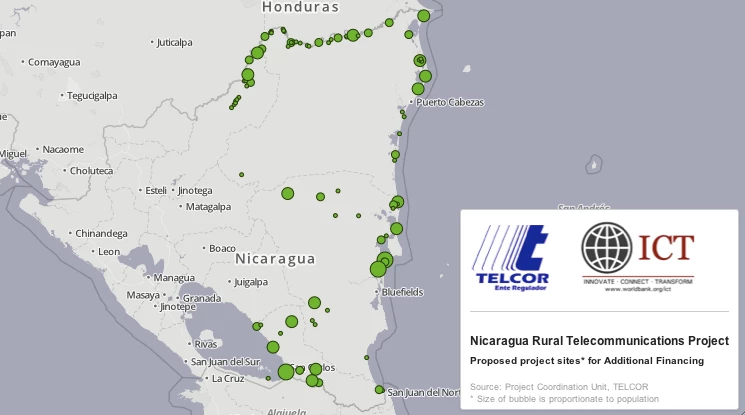The Nicaragua Rural Telecommunications Project was approved by the World Bank Board in 2006. Almost six years later, this project implemented by TELCOR, the national regulatory agency, has been able to extend telecommunications services to rural areas of the country (click the map image above or here to see an interactive map).
Taking stock
Currently, all but three municipalities in the country have broadband points of presence which offer retail services at the same prices as in Managua, the capital city. In more than 100 rural municipalities, the project helped installing telecenters that provide access to citizens, in some cases for free (the cost is absorbed by the municipalities). Additionally, more than 500 pay phones have been installed in communities that are in the outskirts of coverage areas, and in some isolated locations mobile base stations have been partially subsidized. Lastly, the project also complemented work that was being done by the Government of Finland on municipal applications. The project supported the rollout of a cattle branding application in several departments of the country. This application was very well received by local authorities and is expected to help reduce time to register brands, as well as criminal activities (theft and illegal transportation of cattle), and eventually integrate with RFID initiatives that are being piloted in the country.
The most challenging issue has been the sustainability of the telecenters. Whereas many rural municipalities have actively supported the telecenters, some municipal authorities have seen telecenters in their municipality as a burden and have not supported them. In some of these cases, TELCOR has found other partners that now manage the telecenters, and in others telecenters have been removed due to the appearance of competing facilities or due to the lack of interest of the communities and their leaders after several months of operation.
Going forward
As can be seen the map above, the project has focused in the Pacific and Central regions, which concentrate a big portion of the Nicaraguan population. The Caribbean coast of Nicaragua and Rio San Juan department are more challenging regions, with a more scattered population with lower levels of income. Many of these communities are isolated from each other, with no reliable energy power and where the only means of communication is through boats.
The Government of Nicaragua has now requested support to expand communications services in these isolated regions. The Bank is currently preparing additional financing to the original operation that would allow this. The map below shows the communities that would be benefitted by this additional project (click here for an interactive version). Given the challenging environment, the proposed area of coverage is not considered commercially attractive, so the design includes so-called "smart subsidies" that would attract private parties. In general, the idea is to have a company (existing or new) that will rollout a transmission network that will work under an open access scheme and provide retail services in the biggest urban areas of the region. Then, small entrepreneurs in more isolated locations would be able to rollout micro-telco kind of operations that would provide end services in their communities.
The proposed approach is quite innovative and has some inherent risks. However, the team and country officials strongly believe it will increase ownership by these communities. Coupled with complementing initiatives in terms of creation of relevant content and applications for these inhabitants, and the distribution of devices and installation of telecenters in selected communities, this model is expected to increase the chances of financial sustainability.
The additional financing is expected to go to the World Bank Board in mid June 2012.




Join the Conversation